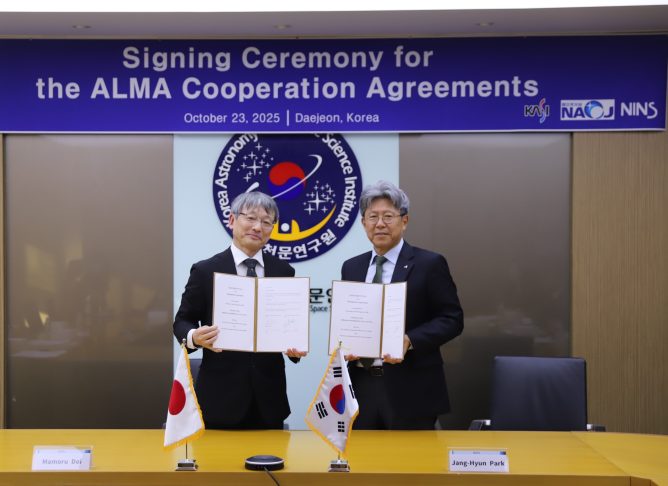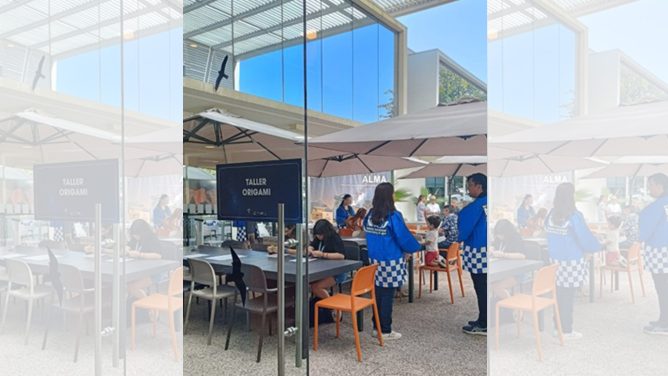Two young ALMA researchers, Dr. Takafumi Kojima at NAOJ and Dr. Takuya Hashimoto at University of Tsukuba received the Young Scientists’ Award, 2021 Commendation for Science and Technology by the Minister of Education, Culture, Sports, Science and Technology (MEXT).

Two researchers received the Young Scientists’ Award, 2021 Commendation for Science and Technology by MEXT; Takafumi Kojima, Associate Professor in the NAOJ Advanced Technology Center (left), and Takuya Hashimoto, Assistant Professor at University of Tsukuba.
Credit: NAOJ, University of Tsukuba
Award Winner: Takafumi Kojima, associate professor at NAOJ Advanced Technology Center
Research awarded: Research on high-sensitivity and wideband receivers for radio astronomy
Kojima is leading the research and development of receivers for ALMA. Since radio waves from distant objects are very weak, the radio receivers need to have very high sensitivity. It is also important to be able to catch radio waves in as wide a frequency band as possible at once in order to capture the signals emitted by various molecules at various frequencies. Kojima contributed to the development of the “Band 10” receiver, which observes the highest frequency radio waves on ALMA, and is continuing his research on the superconducting mixer, which is the core of radio receivers. Kojima is developing a new receiver that can observe four times wider frequency band at once than the current ALMA receiver and has improved sensitivity, and its performance has already been demonstrated in the laboratory. This development is an important step in improving the performance of ALMA, and is expected to make a significant contribution to the achievement of scientific goals in astronomy, such as improving our understanding of the planet formation process and the materials of life, and the search for the starting point of elemental synthesis in the Universe.
“It is a great honor for me to receive such a prestigious award,” says Kojima. “I would like to take this opportunity to express my gratitude to all the people who gave us guidance and support in conducting this research. In particular, this achievement was made possible by the meticulous and steady research activities with several highly skilled research partners. Although we have developed and demonstrated key technologies for the realization of a high-performance receiver in this research, we still have a long way to go before we can actually implement them in ALMA. I will continue to devote myself to the research and development activities.”
Award Winner: Takuya Hashimoto, assistant professor at University of Tsukuba
Research awarded: Observational study of various most distant galaxies using emission lines of ionized oxygen
Hashimoto uses ALMA to study distant galaxies. His main target is ultra-distant galaxies that existed when the age of the Universe was less than a billion years, but it has been difficult to study the properties of these galaxies in detail using spectroscopy due to the lack of sensitivity of telescopes. Using highly sensitive ALMA, Hashimoto has established a method for observing ultra-distant galaxies, especially using the light emitted by oxygen ions. With this technique, he succeeded in observing a galaxy 13.28 billion light-years away, which was the farthest ever recorded in the history of observations at the time of publication (May 2018), as well as a galaxy 13.1 billion light-years away, the farthest ever merging galaxy. He established a global trend in the study of ultra-distant galaxies using ALMA, and made a significant contribution to our understanding of the birth and evolution of galaxies in the early Universe.
“I am very happy to receive this wonderful award. I would like to express my gratitude to my collaborators, those who have involved in ALMA, and everyone who has been involved with me. When I look back on the time when we were working on this research, I can still recall the excitement I felt when I saw the signal from the very distant galaxy after analyzing the ALMA data. I was so excited that I could not sleep well that day. Once we were sure that the signal was the light emitted by doubly-ionized oxygen ions, we had many discussions with our collaborators, and I fondly remember the wonderful days when we created these great works. Today, many researchers utilize the combination of ALMA and the light emitted by oxygen ions to study distant galaxies. It is a great honor to have pioneered a new field of research. I will continue to work with many people to perform interesting research and make a contribution to the development of astronomy.” says Hashimoto.
Additional Information
– Press release issued on May 17, 2018: “ALMA Finds Oxygen 13.28 Billion Light-Years Away – Most Distant Oxygen Indicates Mature Nature of a Young Galaxy”
– Press release issued on June 18, 2019: “ALMA Finds Earliest Example of Merging Galaxies”
Researchers related to ALMA have received the Commendation for Science and Technology by MEXT three times.
In 2011: Band 10 Team won the Commendation for Science and Technology by MEXT
– Award winner: Yoshinori Uzawa (NAOJ), Yasunori Fujii (NAOJ), Zheng Wang (National Institute of Information and Communications Technology)
– Research awarded: Pioneering research of terahertz receiver technology using superconducting niobium nitride mixers
In 2013: Three Japanese ALMA Researchers Won Commendation for Science and Technology by MEXT
– Award winner: Masato Ishiguro (NAOJ), Tetsuo Hasegawa (NAOJ), Satoru Iguchi (NAOJ)
– Research awarded: Research of aperture synthesis telescope for high-precision imaging
In 2016: Japanese ALMA Antenna Development Team Won Commendation for Science and Technology by MEXT
– Award winner: Masao Saito (NAOJ), Norikazu Mizuno (NAOJ), Noboru Kawaguchi (Mitsubishi Electric Corporation) , Takeharu Oshima (Mitsubishi Electric Corporation), Satoru Iguchi (NAOJ)
– Research awarded: Development of high-precision ALMA submillimeter antenna









